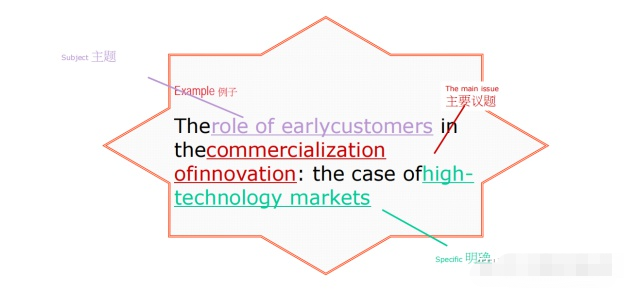【摘要】 一. Starting 事前准备 Check the originality of your idea 检查原创性
一. Starting 事前准备
Check the originality of your idea 检查原创性
① Have you done something new and interesting? 你有做了些新的引人兴趣的事吗?
② Is there anything challenging in your work? 在你的研究工作中有任何挑战吗?
③ Is the work directly related to a current hot topic?研究工作与目前热门主题有直接关联吗?
④ Have you provided solutions to any difficult problems? 你有对任何困难的问题提供解决之道吗?
If all answers are “yes”, then start preparing your manuscript. 如果全部的答案都是“yes” ,那么就可开始准备你的论文
如果刚开始写英文文章的话,可以寻找一些写作工具,搭建SCI文章框架
https://link.zhihu.com/?target=https%3A//www.citexs.com/Writing
二. Construction of an article 论文架构
1.Title 论文题目
A good title should contain the fewest possible words that adequately describe the contents of a paper. 一个好的题目应该只含可适当地描述论文内涵的最少可能字数。
Effective titles 有效的题目
*Identify the main issue of the paper 确认论文的主要议题
*Begin with the subject of the paper 从论文的主題开始
*Are accurate, unambiguous,specific, and complete是精准、清楚、明确且完整的
*Do not contain infrequently-used abbreviations 不含罕用的缩写
*Attract readers 吸引读者
title example

◇ Characterization Of Selenocysteine (SEC) tRNA Population in Drosophila.
◇ Nonrandom Cytogenetic Alterations in Hepatocellular Carcinoma from Transgenic Mice Overexpressing c-Myc and Transforming Growth Factor Alpha in the Liver.
2.Abstract 摘要
There are 3 main types of abstract 有3种主要摘要类型
*Indicative (descriptive) abstract 叙述性摘要
outlines the topics covered in a piece of writing so the reader can decide whether to read the entire document. Often used inreview articles or conference reports. 略述文章所含概的论题,如此读者可以决定是否要看整篇论文。常用于评论论文或研讨会报告
*Informative abstract 信息性摘要
summarize the article based on the IMRAD structure, but without these words explicitly presented 依IMRAD结构来概述论文但没有明确呈现这些文字
*Structured abstract 架构性摘要
Followsheadings required by the journal. Often used in Medical journals.遵循期刊所要求的标题。常用遵循期刊所要求的标题。常于于医学类期刊
Check carefully which type fits the journal of your choice.仔细检查哪种摘要类型适合你所选的期刊
The abstract: the advertisement of your article
*precise and honest 精准且诚实
*Can stand alone 可以独立
*Uses no technical jargon 不用专业术语
*Is brief and specific 简短且明确
*Cites no references 没有引用参考文献
3.Keywords: Used for indexing
*Check the Guide for Authors! (Number label definition, thesaurus, range, and other special requests) 检查作者指南! (数字、 标示、定义、汇编、页数与其他特别要求)
*Words selected should reflect the essential topics of the article... Do not select “marketing”.
所选的字应该要反映出论文之基本论題…
*Only use abbreviations firmly and unambiguously established in the field 只使用在该领域明白地确立的缩写。
4.Introduction: convince readers that your work is important
Answer a series of questions: 回答一系列问题:
*What is the problem?问题是什么?
*Are there any existing solutions?有任何现行的解决方法吗?
*Which is the best?哪一个是最好的方法?
*What is its main limitation?其主要限制是什么?
*What do you hope to achieve?你希望可以达成什么?
Provide sufficient background information to help readers evaluateyour work.
General background (review articles cited)→>problems investigated particularlyin this piece of research (review the mainpublications on which your work is based.)
一般背景(回顾所引用的文章)→在本研究中所特别钻研的问题(探讨你的研究所根据的主要论文著作)
Convince readers that your work is necessary 说服读者们你的研究是有其必要性。
Use words or phrases like "however""remain unclear" , etc., to address your opinions and work使用字或词组像“然而”、“仍然不明”等来提及你的意见与研究
Pay attention to the following 注意以下事项
*You want to present your new data, but you must put them into perspective first你想要展示你的新数据﹐但是你必须要先透视它们
*Be brief, it is not a history lesson简洁有力﹐这不是历史课
*Do not mix introduction, results, discussion and conclusions. Keep them separate不要混淆绪论﹑结果﹑讨论与结论。将它们分开
*Do not overuse expressions such as "novel", "first time", "first ever"不要过度使用像是"新颖的”﹑"首次”﹑"破天荒第一次"的措辞·
5.Methods
①how did you study the problem?
The basic principle: to provide sufficientinformation so that a knowledgeable reader can reproduce the experiment, or the derivation.基本原则:提供充足的信息以便有见识的读者可以复制此试验或研究起源
*Empirical papers实证论文
material studied, area descriptions研究材料,区域说明
methods, techniques, theories applied方法、技巧、所应用的理论
*Case study papers个案研究论文
application of existing methods, theory or tools现存方法、理论或工具之应用
special settings in this piece of work此研究的特别情景
*Methodology papers方法论论文
materials and detailed procedure of a novelexperimentation一项新颖实验的材料与细节过程
scheme, flow,and performance analysis of a newalgorithm一个新算法的计划、流程与绩效分析
②analytical techniques? 分析技巧?
*Describe analytical methods if not universally understood解释不被普遍了解的分析方法
*Why was this method chosen?为什么选择这个方法?
*What are the method' s data requirements?使用这个方法的数据必要条件是什么?
*What are the major concerns when using this technique?用这个方法时的主要顾虑是什么?
*If necessary cite justification for selection of the method.如果有需要引述正当的理由来解释为何选择此方法。
6.Results– what have you found?
①The following should be included in this part.研究结果应包含以下部分
*The main findings listed in association with the methods与研究方法有关联的主要发现陈述
*The highlighted difference between your results and theprevious publications (especially in case study papers)你的结果与先前的论文著作(尤其是个案研究论文)之间的差异显现
*Results of statistical analysis 统计分析结果
*Results of performance analysis (especially in methodology, or algorithm papers)绩效分析结果(尤其是方法论或算法性论文)
*A set of principle equations or theorems supporting the assumptions after a long chain of inferences (especially in thetheory papers)在一长串推论后,一组支持假定的原理方程式或定理(尤其是理论性论文)
②Make captions self-sufficient 使标题一目了然
The captions of figures and tables should contain sufficient information to make the figures selfexplanatory 图表标题应有充足的信息使图一目了然,不需再多加解。
注意以下事项
① No illustrations should duplicate the information described elsewhere in the manuscript.图表的说明不应复制自论文内在其他处已叙述的信息
② Do not use confusing figures! 不要用令人眼花瞭乱的图
③Appearances count! 外观重要
*每个图绘制3或4个数据集;
*使用副图面板来组装能说明同一类型问题的图
*精选尺度; 适当的轴标号大小;符号清晰可见,数据集容易区分
7.Discussion(讨论) – what the results mean
① Check for the following:检查以下事项:
* How do your results relate to the original question or objectives outlined in the Introduction section?你的结果是如何与原本在绪论中所概述的研究问题或目标有相关?
* Can you reach your conclusion smoothly after your discussion?你可以在讨论完后,很顺畅地得出你的结论吗?
* Do you provide interpretation for each of your results presented?你有为每一呈現的结果提供解释吗?
*Are your results consistent with what other investigators have reported? Or are there any differences? Why?你的结果与其他研究者所记述的结果一致吗?或是有不同的差异?为什么?
*Are there any limitations?有任何限制吗?
② Do not不要
*Make statements that go beyond what the results can support做超出结果所能支持的陈述
*Suddenly introduce new terms or ideas突然介绍新的术语或想法
③ Quantitative description is always preferred.数量化叙述总是较好的
(Poor : There was a significant relationship between last year’s satisfaction score and this years profit margins.
Better: There was a.72R2 between profit margin and year earlier customer satisfaction scores)
8.Conclusion(结论)
*提出与研究目标有关的全面和具体结论。
*指明使用,扩展和限制(如果适用)
*建议未来的实验并指出正在进行的实验
免责声明:部分文章整合自网络,因内容庞杂无法联系到全部作者,如有侵权,请联系删除,我们会在第一时间予以答复,万分感谢。











 您已经拒绝加入团体
您已经拒绝加入团体

 2022-10-08
2022-10-08
 6185
6185
 0
0










